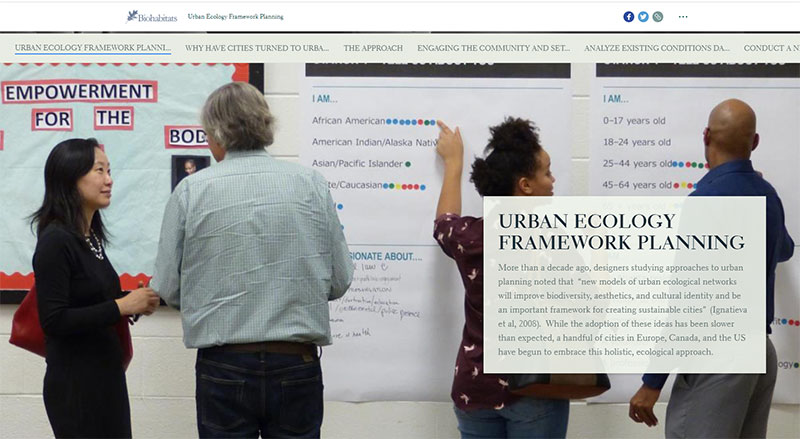Biohabitats Projects, Places, and People
By Amy Nelson
Projects
Restoring Chagrin River Headwaters
Restoration construction is underway on Beaver Creek, located in the headwaters of the Chagrin River in Ohio’s Bass Lake Preserve. The Chagrin River has been designated as a State Scenic River for its exceptional aquatic habitat and riparian forests, but Beaver Creek had been straightened and impacted by agricultural land use. With funding from Ohio EPA’s Water Resource Restoration Sponsor Program, the Geauga Park District and the Chagrin River Watershed Partners sought to restore a natural channel flow to the creek and regenerate floodplain and wetland habitat to improve water and habitat quality for Bass Lake and the Chagrin River Watershed. We’ve been implementing the design-build effort, along with our subcontractor, Meadville Land Service. Once the restoration is complete, however, folks might assume the creek was designed by its namesake, since it will take the shape of a multi-branched channel. For more information about this project, please contact Kevin Grieser.
Leave it to Beaver in Pittsburgh
In the early 2000s, Biohabitats helped the City of Pittsburgh and the U.S. Army Corps of Engineers develop and implement a comprehensive plan to restore Nine Mile Run, a stream that had suffered from decades of urban and industrial development. Ultimately, the project transformed two-miles of the degraded stream and its riparian corridor into a riverine park with thriving natural systems and recreational amenities. Recently, residents began expressing concerns about beaver that had taken up residence in the park and had begun taking down trees. To determine the best course of action, the Nine Mile Run Conservancy turned to Biohabitats. By leading Conservancy members on a “Beaver Walk” and meeting with City officials, Biohabitats senior ecologist, Joe Berg, helped constituents understand the benefits of beaver in the stream, and recognize the beaver not as a nuisance to be removed from the site, but as a collaborator in the ongoing regeneration of the stream corridor’s ecology.
A Growing Relationship
The Nature Conservancy oversees Ohio’s Stream and Wetland In-Lieu Fee Mitigation Program (OMP), which restores and protects streams and wetlands for future generations while offsetting unavoidable environmental impacts from economic development. Earlier this year, to offset impacts to the Little Miami River watershed, OMP initiated the restoration of Jacoby Branch, a stream that flows through a regenerative farming site known as Agraria. A program of the Arthur Morgan Institute for Community Solutions (AMICS), Agraria is Ohio’s first Center for Regenerative Agriculture. Long ago, Jacoby Branch was straightened and tile drained to support the site’s former agricultural use. We are thrilled to be helping TNC, Agraria, and AIMCS restored 6,300 linear feet of Jacoby Branch and its tributaries into an ecologically functioning stream corridor, complete with 1.7 acres of newly created wetlands and 1 acre of enhanced existing wetlands. Agraria uses its property to teach people holistic, regenerative farming practices, and part of our restoration includes the establishment of a permaculture forest, where native fruits and nuts can be harvested. We’re currently in the preliminary design phase of the project and construction is slated for later this year. For more information about this project, please contact Suzanne Hoehne.
Talk about Sticking the Landing!
This past year we worked with Anne Arundel County Bureau of Watershed Protection and Restoration to design the restoration of Beard’s Creek, an eroding tributary of the South River, which flows directly into the Chesapeake Bay. Located in the Annapolis Landing neighborhood of Riva, the degraded stream had become a source of nutrient and sediment loads to the South River and impaired the habitat value. We are delighted to report that we are now working with the Arundel Rivers Federation, a nonprofit dedicated to protecting, restoring, and enhancing the waters of the South, West, and Rhode Rivers, to bring that design to life. The design includes the use of all wood structures to improve both stream and floodplain wetland conditions, and we were assisted in its construction by Meadville Land Service. Construction wrapped up in March 2021 and planting is currently underway, to be completed in early April. For more information about this project, please contact Joe Berg.
Going with the Flow in New Jersey’s Teaneck Creek Park
Over the past few years, we’ve been collaborating with Bergen County Parks and the Teaneck Creek Conservancy to restore ecological function, public use, and beauty to Teaneck Creek Park, one of the few remaining natural open spaces in the county. We are happy to report that wetland restoration is well underway. Pools and flow paths have been installed, and regenerative stormwater conveyance systems are nearly complete. For more information about this project, please contact Kevin Dahms.
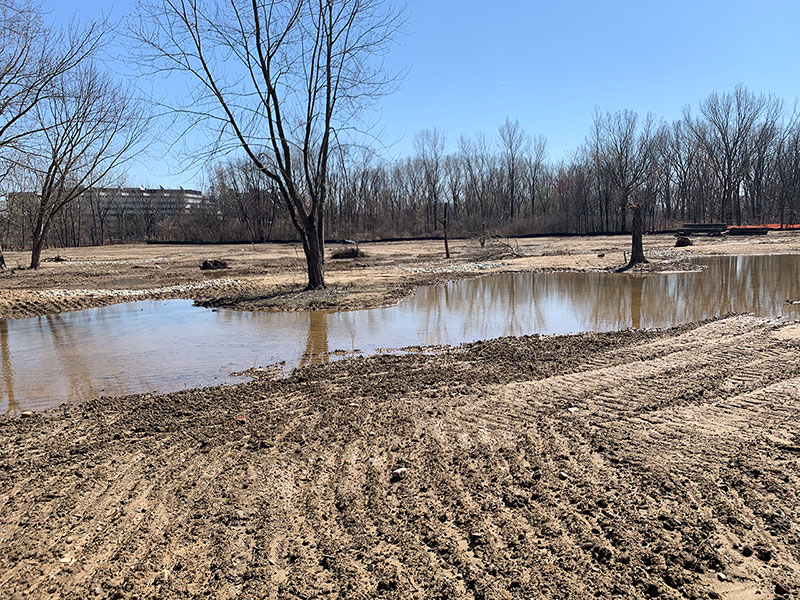
Equitable Conservation in the Rapidly Growing Denver Metro Region
The Nature Conservancy is a founding member of the Metro Denver Nature Alliance (Metro DNA), a growing coalition of non-profit, government, research, and private sector partners seeking to align nature-based efforts to ensure more equitable access to nature and to promote healthy people, communities, and natural places. We’re honored to be one of those partners, and thrilled to be working with TNC and Metro DNA to help ensure a greater prioritization of nature in land-use decisions by conducting a regional conservation assessment. The Metro Denver region, which spans seven counties, is facing explosive population growth, so the need to identify, prioritize, and equitably conserve and restore natural areas is critical. Over the past several months, we have been working with a Technical Advisory Team to develop the framework and inputs for high quality habitat mapping. Next, we’ll begin the connectivity analysis, which will identify priority locations and pinchpoints for wildlife movement. Our ultimate goal is to create a comprehensive conservation map that identifies core areas, corridors, critical gaps, connectivity barriers, and important conservation and restoration opportunities. When combined with an equally rigorous social assessment and other considerations, the ecological assessment will help our partners plan holistically and prioritize actions in a way that helps people and nature thrive in the Denver Metro area. For more information about this project, please contact Claudia Browne.
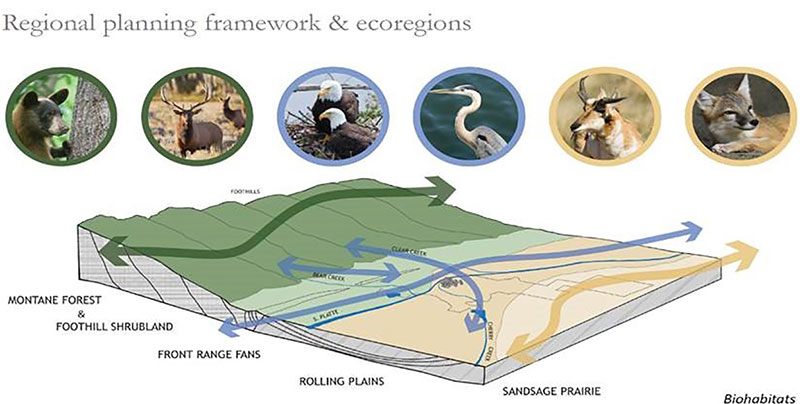
Restoration in a city’s backyard…literally.
Located just behind Brooklyn, Ohio’s City Hall, is Veteran’s Memorial Park, one of the city’s largest recreational sites. Stormwater from surrounding development has been eroding Stickney Creek, which flows through the park, to the point at which gabion baskets along its banks had begun collapsing. Recognizing the need for a more resilient, nature-based solution, the City of Brooklyn and the West Creek Conservancy turned to Biohabitats. We’re thrilled to report that gabion baskets and failing asphalt were removed from the banks and replaced with the bioengineering techniques including soil lifts and toe wood with live-branch layering. These techniques will restore floodplain connectivity, stability, ecological function, and habitat to Stickney Creek.
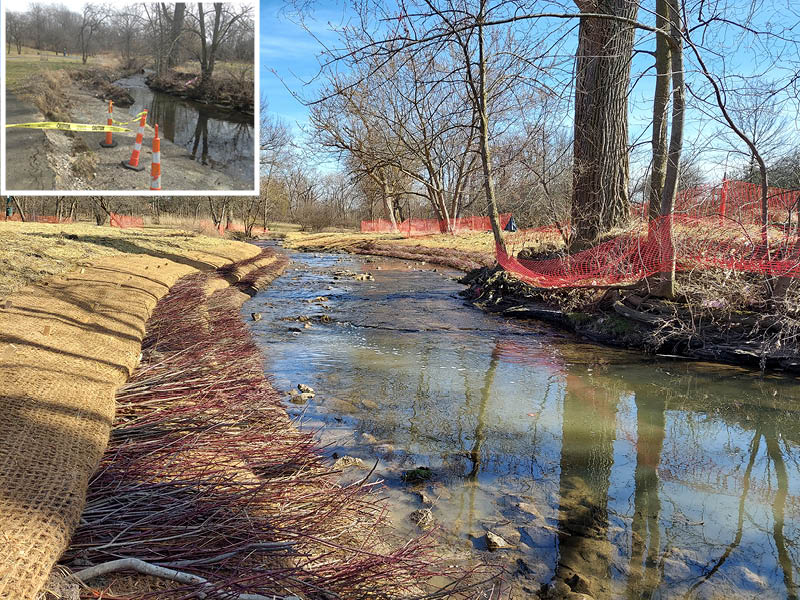
The restoration also involves the creation of wetland pools in the floodplain, which will add more floodplain function to the system. We always try to repurpose onsite materials in our projects, and this restoration is no exception. Woody material was used as in-stream and wetland habitat features while the rock material from the gabions was incorporated into the bioengineering, stormwater outfall stabilization, and constructed riffle. Funded by OhioEPA and NEORSD, the project was also supported by project partners West Creek Conservancy, City of Brooklyn and Big Creek Connects. For more information about this project, please contact Kevin Grieser.
Shoring Up Resilience
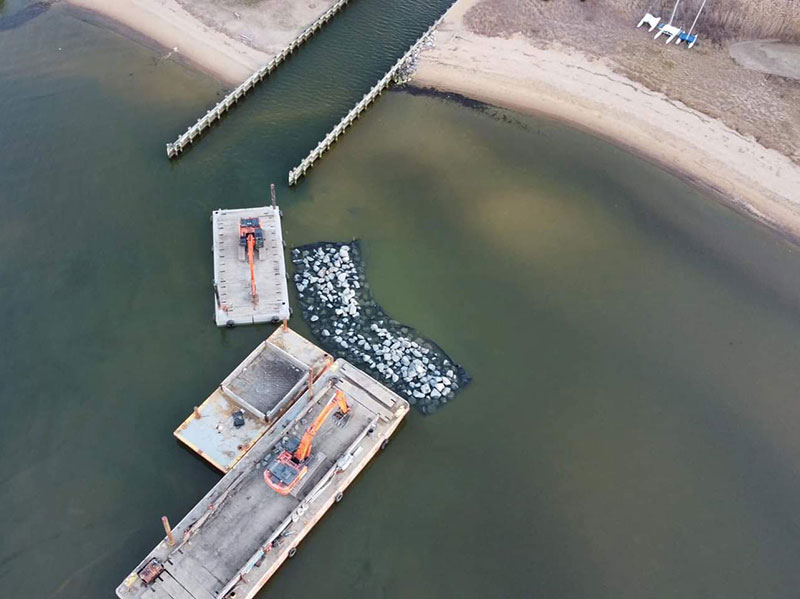
Last month, we began construction on the first of two shoreline protection and restoration projects for the community of Cape St. Claire in Annapolis, MD. Working closely with the Community Association and the Alliance for the Chesapeake Bay, we developed designs for two sites along the shore. At the confluence of the Magothy and Little Magothy Rivers, next to the community park and beach, a headland breakwater with a small groin was designed to stop erosion and restore processes that would allow beach accretion. At a second site, our strategy involves placing reef balls and large trees with intact roots near the outlet from a 4-acre stormwater pond to create a complex shallow water environment ideal for fish and waterbirds. Construction of the first site was completed in March, with shoreline plantings completed mid-April. The second site is slated for construction late Fall and we promise to keep you posted! (Aerial photo by Dave Minter + Tom Ripley) For more information about this project, please contact Joe Berg or Jim Favret.
Frequently Flooded Farmland Transformed into Nature Preserve
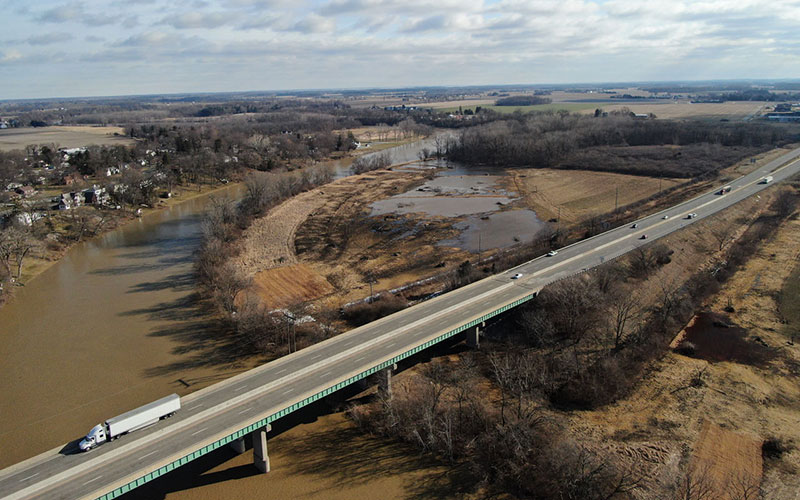
Thanks to the vision of the Black Swamp Conservancy, a new nature preserve is coming to life in Freemont, Ohio! When the Conservancy acquired 54 acres of frequently-flooding farmland along a bend of the Sandusky River, they knew it offered the potential to create and enhance wetlands and ultimately improve water quality to the River. Along with our construction partners at Meadville Land Service, we’ve been helping the Conservancy realize this vision by reconnecting the river to its floodplain, regenerating a natural, vegetated wetland/riparian zone, and restoring 20 acres of upland native meadow habitat. Earthwork for the new Redhorse Bend Nature Preserve wrapped up earlier this winter, and native plant installation is right around the (you guessed it) bend. The project is being funded by a grant from the H2Ohio Program, a statewide initiative to ensure safe and clean water for all Ohioans. For more information about this project, please contact Kevin Grieser.
Learn How to Use Ecology as a Foundation for Urban Planning
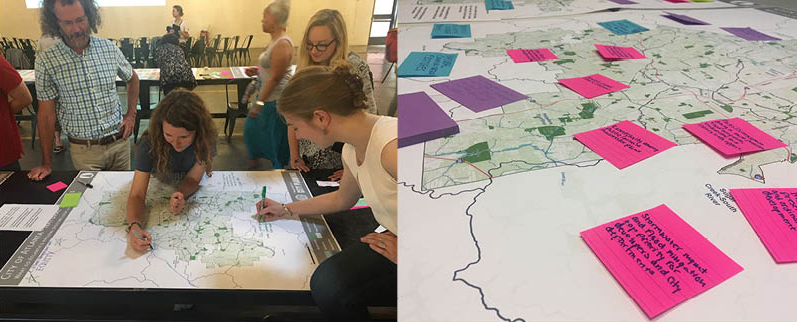
Many cities are turning to ecology as a foundation for planning future resilience. But how, exactly, do you infuse ecological principles into urban planning? We’re pleased to share that as we’ve continued to refine our approach to socio-ecological urban planning frameworks, we have created tools to help guide you through the process. For visual learners, we are excited to share our Urban Ecology Storymap. This interactive platform combines maps, data, audio, video, photos, and narrative to share the stories of cities and regions that have woven ecology and equity into their planning processes.
The Storymap can be a great way to bring this idea to life for members of your community, stakeholders, and future funders. We have also developed a free, three-episode Habitat Happy Hour webinar series devoted to Urban Ecology Frameworks for City Resilience Planning. The first episode, Context and Process: Ecology and the City, will take place on May 5. Episode 2, Iterative Engagement & Analysis: Storytelling Nature’s Patterns, will take place on May 19. Episode 3, Laying the Groundwork for Implementation: Scenarios, Pilots, and Partnership, will take place on June 2. Registration for all three webinars is now open! For more information, contact Jennifer Dowdell.
Award-Winning Work
Introducing the newest certified Living Building: The Kendeda Building for Innovative Sustainable Design
Georgia Tech’s Kendeda Building for Innovative Sustainable Design has just become the first building in the state of Georgia-and the 28th in the entire world-to be certified as a Living Building. The Living Building Challenge is the most stringent sustainability certification program that exists for the built environment. The building has also been recognized by the American Institute of Architects’ Committee on the Environment (AIA COTE) as a Top Ten Award winner. AIA COTE Top Ten Awards are the industry’s best-known award program for sustainable design excellence. Winners are selected based on rigorous criteria for social, economic, and ecological value.
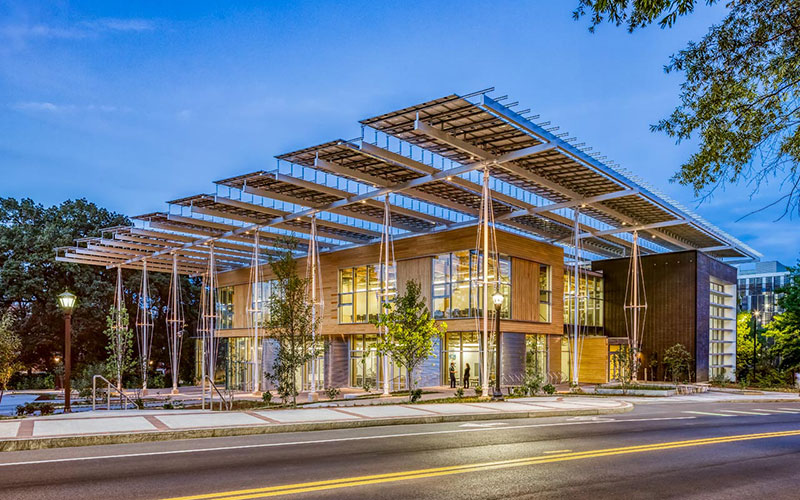
A key member of the integrated design team led by Lord Aeck Sargent and Miller Hull, we helped the Kendeda Building reach its radically high level of performance by planning the overall water cycle strategy and designing its greywater and condensate infrastructure to yield net zero water. This means the building supplies all of its own water needs, treats all of its wastewater and manages all of its stormwater onsite, and returns clean water to the Earth and downstream communities. For more information about this project, please contact Erin English.
Stream Restoration Projects Recognized Among Best Urban BMPs in the Bay
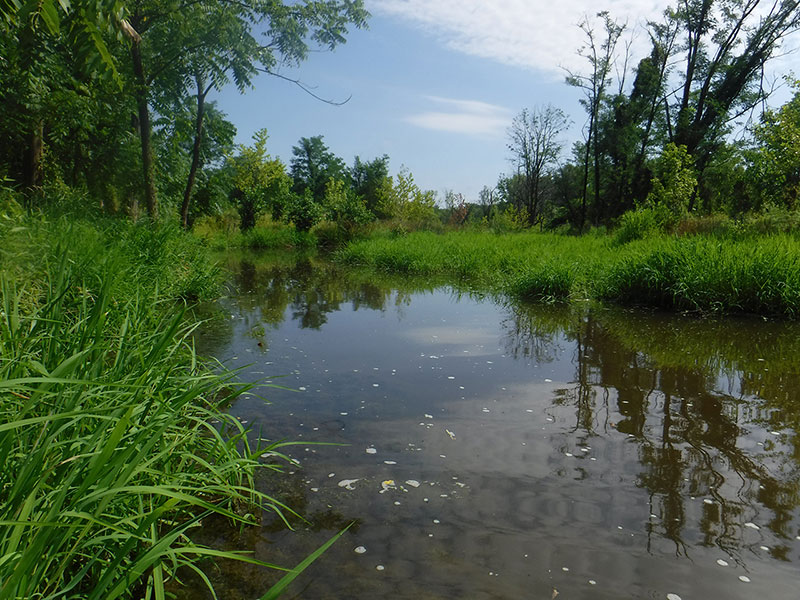
We’re thrilled to share the news that the Davis Branch Stream Restoration, a project we undertook with the Howard County Maryland Stormwater Division, Howard County Rec & Parks, the Howard County Conservancy, and Ecotone, earned a BUBBA (Best Urban BMP in the Bay) Award! Awarded first place by the Chesapeake Stormwater Network in the category of Best Stream Restoration, the project was recognized as “a great example of comprehensive restoration design that ties together habitat improvement, monitoring and adaptive management throughout the project to achieve a resilient stream and floodplain system.”
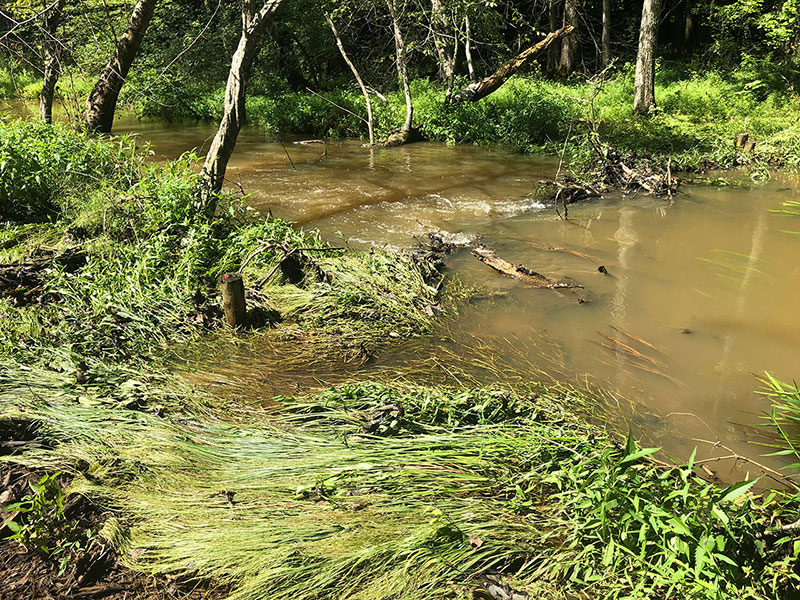
The restoration of Bacon Ridge Branch at the Elks Club Camp Barrett, a youth camp in Anne Arundel County, Maryland, won third place in the same category. We collaborated with GreenVest, EQR, and Coastal Resources on that project for the Maryland State Highway Administration. We used woody materials found on site to create in-stream log jam structures to raise the water surface elevation and reconnect the stream to its floodplain. For more information about the Davis Branch stream restoration, please contact Jim Cooper. For more information about the restoration of Bacon Ridge Branch at Elks Camp Barrett, please contact Joe Berg. Congratulations to all BUBBA winners!
Places
Living Future, the flagship event of the Living Future Institute, the organization behind the Living Building Challenge, is taking place online as you read this. The theme this year is “Inclusion + Unity.” On Wednesday, April 21st, Juan Rovalo spoke about the Reserva Santa Fe, a Living Community Challenge project in Mexico, and he participated in a Spanish language education session on Diseño Regenerativo en Latinoamérica. On Friday, April 23, Erin English will present “Taking the Plunge: Water Petal lessons from the field session.”
The annual conference of the Midwest/Great Lakes Chapter of the Society for Ecological Restoration, which began on April 19 and will continue through April 29, has also been taking place virtually. Kevin Grieser and Suzanne Hoehne presented “Managed succession as a restoration strategy.” On April 21, Kevin will take to the virtual podium again on April 25 to present “Start with schools: stream restoration & STEM, a perfect match.” Suzanne will present again on April 27, with “Should a stream channel really be there? The idea of stage 0 restoration,” on April 27.
On April 28, Erin English will be featured in Vol. 10 of Friends of Architecture Santa Fe’s PechaKucha series. The theme of the night is FLOW, and Erin will be joined by advocate Maureo Fernandez Y Mora, music educators Brian Nelson and Lindsay Taylor, and ultrarunner/photographer Rickey Gates.
We’re honored to sponsor this year’s Ohio Stormwater Conference, which will take place May 21-22. The hybrid event offers in-person and virtual participation. Biohabitats is honored to sponsor the event. Regardless of how you plan to participate, don’t miss Kevin Grieser’s presentation of Creating a Stream/Wetland Complex with Sand Seepage Berms and Elena Stachew’s talk on “Biomimicry as Nature-Based Methodology for Coastal and Stormwater Infrastructure Design.”
On May 25, Joe Berg will be joined by Ecotone’s Scott McGill to present a webinar on “Innovative Riparian Corridor Restoration Approaches.” The webinar will be hosted by North Carolina State University’s Department of Biological and Agricultural Engineering.
June 21-24 the Society for Ecological Restoration will hold its World Conference virtually. This year’s event is “A New Global Trajectory: Catalyzing Change Through the UN Decade on Ecosystem Restoration,” and we are delighted to be a sponsor. The conference will also include weekly virtual field trips beginning May 7. This is an important time for the restoration community to come together, and we’ll certainly be at the virtual podium. Joe Berg and Doug Streaker will be joined by David Merkey of GreenVest to present a workshop on the use of engineered wood structures harvested on-site to restore streams and floodplain wetlands though restoration of shallow groundwater and floodplain hydrology. Susan Sherrod will present a talk on “Salvage and Restoration of Biological Soil Crust on an Urban Superfund Site, Midvale, Utah.Biohabitats is also hosting a symposium entitled Green Infrastructure, Ecology & Restoration: Nature Based Solutions Lead the Way. Our session focuses on integrating ecology in multidisciplinary and cross-sectional collaborations. Led by Keith Bowers, the symposium includes talks by Jennifer Dowdell, Claudia Browne, and Aiman Duckworth, exploring community engagement, urban ecology and green infrastructure planning, design, policy, and the geospatial tools and techniques that inform these planning efforts.
Be part of one of the biggest worldwide efforts for restoration ever! Typically held during the SER World Conference, the one-day hands-on volunteer event known as “Make A Difference Day” will become “Make a Difference Week” this year. Beginning on World Environment Day, and the official launch of the UN Decade on Ecosystem Restoration, “Make a Difference Week” is an opportunity for individuals, governments, clubs, schools, NGOs, and SER regional chapters and student associations to organize locally relevant, volunteer-led, and COVID-safe events. Event suggestions from SER include restoration plantings, seed collection and seedball making, invasive plant pulls, garbage pick-ups, river clean-ups, or fencing removal. If you plan to participate, please let SER know by emailing ser2021@conferium.com.
People
Kevin Grieser has been promoted to the position of Great Lakes Bioregion Team Leader. Kevin has been applying his expertise in ecology, landscape architecture, and project management to lead projects throughout the Great Lakes bioregion for more than a decade. In his new role he will also lead the bioregion’s operations and business development initiatives.
Doug Streaker and Mike Lighthiser have both been promoted to the positions of Principal Engineer. In their newly expanded roles, Doug and Mike will guide Biohabitats’ engineering practices for the Eastern and Western regions, respectively. They’ll also continue to infuse creativity into our designs while insuring the highest level of engineering integrity.
Rebecca Winer-Skonovd has been promoted to the position of Senior Project Manager. In this role, Rebecca will nurture client relationships, administer contracts, oversee the successful delivery of our services, and serve as an ambassador for our work related to watershed planning, green infrastructure, and MS4 program compliance.

Katherine Bartter has been promoted to the newly created position of People & Culture Leader. In this role, Katherine will be charged with safeguarding and improving Biohabitats’ culture, values, and team member engagement, training, and development.
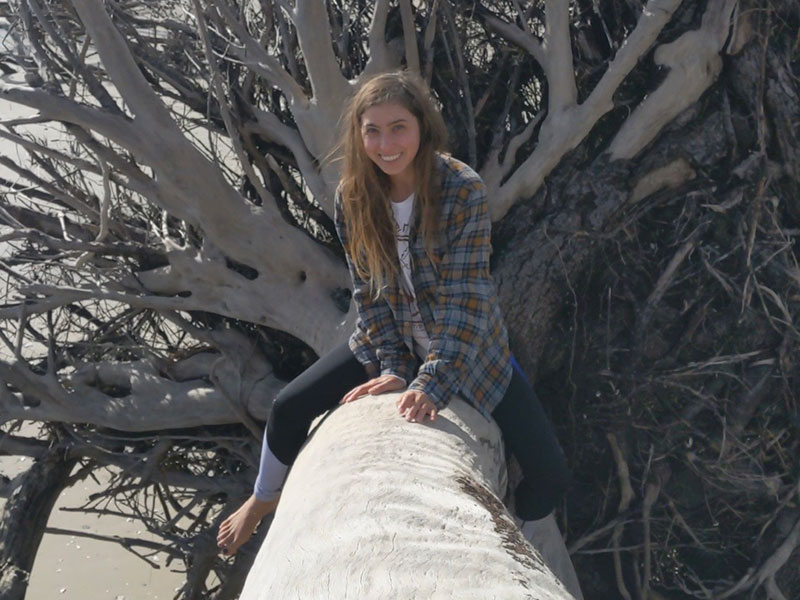
Having achieved certification as a senior ecologist from the Ecological Society of America, and having continued to play an instrumental role in elevating Biohabitats ecological services, Susan Sherrod has been promoted to the position of Senior Ecologist.
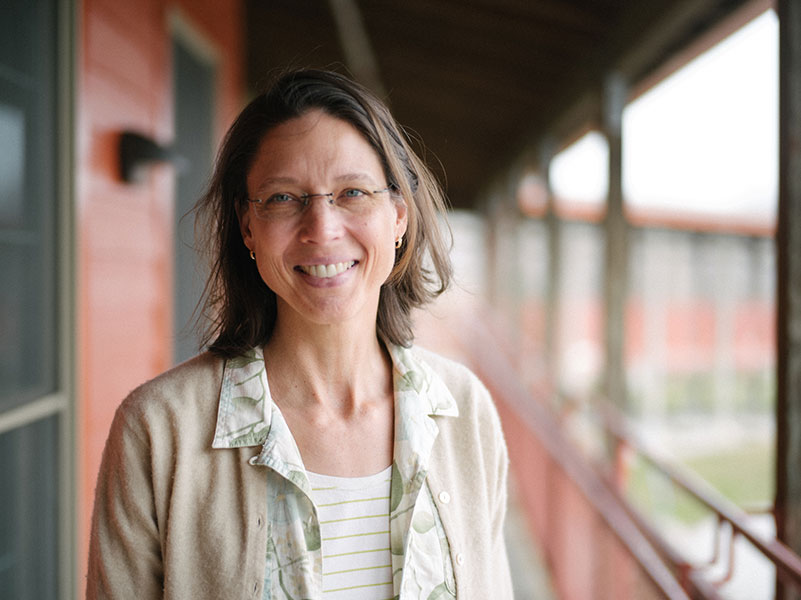
Suzanne Hoehne, who has contributed her skills in engineering, hydrology, and ecology to countless Biohabitats planning and restoration projects over the past 15 years, has been promoted to Senior Ecological Designer.
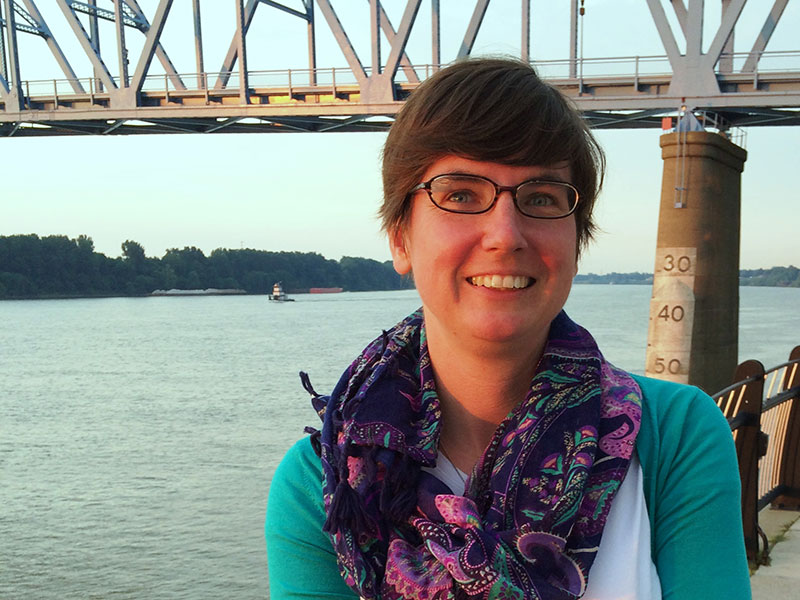
Meghan Gloyd, who continually applies her expertise in stream restoration and stormwater management to help communities improve water quality and meet stringent stormwater permit requirements, has been promoted to Senior Water Resources Engineer.

Certifiably Awesome!
Congratulations to these Biohabitats team members on their recent achievements: Susan Sherrod has been certified by the Ecological Society of America as a Senior Ecologist. Senior Environmental Scientist, Bryon Salladin, received his Wilderness First Aid Certification from the National Outdoor Leadership School. Landscape Architect, Andi Rutherford, has been certified as an Interpretive Guide by the National Association for Interpretation.
Meet our Newest Team Member
Earlier this spring, we welcomed our new Proposal Coordinator, Suzanne Greene. Suzanne is based in the Chesapeake/Delaware Bays Bioregion and she is already applying her creativity and her knowledge of landscape architecture and design to the creation of compelling proposal packages. Get to know the woman behind those packages by visiting the Rhizome Blog.
